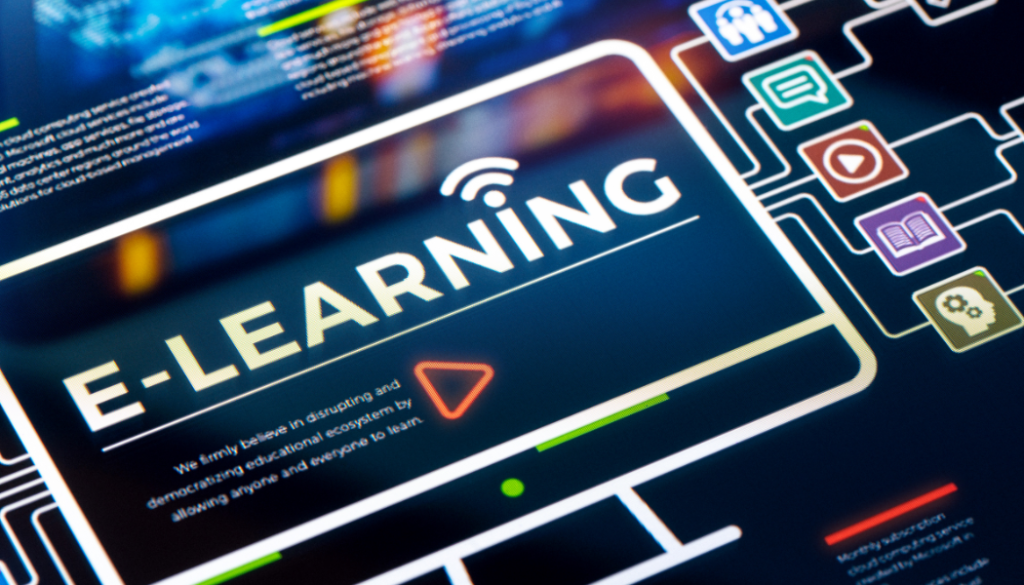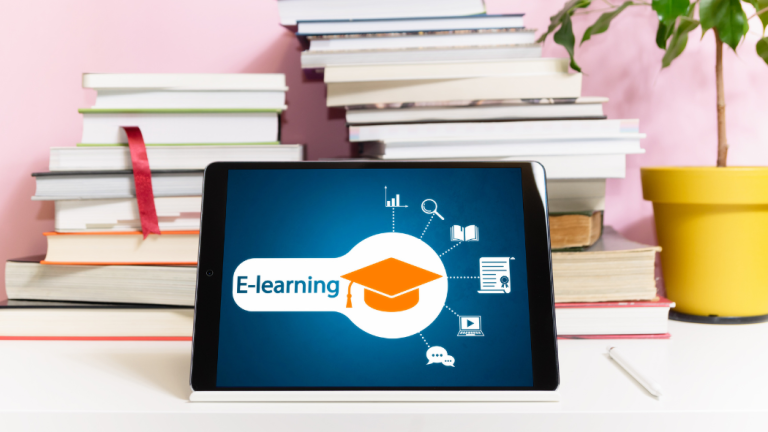E-learning has undergone a significant transformation, evolving from a niche educational tool to a mainstream powerhouse that is reshaping the way knowledge is acquired and disseminated. This evolution has been largely fueled by the COVID-19 pandemic, which compelled a rapid shift towards remote learning and drastically altered societal perceptions of online education.
E-learning offers flexibility and efficiency, empowering individuals to learn at their own pace, anytime, and from anywhere. As a result, the e-learning market is experiencing robust expansion, with a market size valued at USD 399.3 billion in 2022 and a projected growth rate (CAGR) of 14% between 2023 and 2032
This blog post examines the key aspects of creating effective e-learning materials, including various formats, benefits, customization strategies, and essential considerations for development.
Understanding the Evolving Landscape of E-Learning

E-learning leverages electronic devices to deliver learning materials, offering a departure from traditional classroom settings. This shift has democratized education, making it accessible to a global audience and accommodating diverse learning styles. The surge in remote learning, fueled by increasing internet penetration and the demand for flexible education solutions, is a key driver of this growth.
What are the Key Advantages of E-Learning
E-learning has transformed the way we learn. Here are some of its key advantages:
- Self-paced learning: Learners can progress through the material at their own speed, revisiting challenging concepts and accelerating through familiar ones. Studies show that self-paced e-learning can increase information retention by 25-60%.
- Real-time assessment: E-learning platforms often incorporate quizzes, tests, and interactive exercises that provide immediate feedback, allowing learners to gauge their understanding and reinforce their knowledge.
- Accessibility: E-learning materials can be accessed from various devices, including computers, mobile phones, and tablets, allowing learning to occur anytime, anywhere. This aligns with the increasing prevalence of mobile learning, which is expected to witness significant growth in the coming years.
Moving beyond a one-size-fits-all approach, the e-learning landscape now embraces various formats, each designed to resonate with diverse learning styles and preferences.
Catering to Every Learning Style: The Power of Diverse E-Learning Formats
The adaptability of the digital learning environment empowers educators and designers to leverage a rich spectrum of formats, moving beyond the limitations of traditional lectures and textbooks. For instance:
- Video and video formats: Video remains a dominant force in online learning, delivering visual explanations, demonstrating processes, and conveying complex information effectively. Formats such as MP4, MOV, and WebM ensure compatibility across a wide range of devices. The increasing internet traffic dominated by video content underscores its importance in e-learning.
- Animation formats: Animation enhances engagement and makes abstract concepts more accessible through dynamic visuals and storytelling. Formats like GIF, SVG, and Lottie offer flexibility and interactivity, contributing to more engaging learning experiences.
- PowerPoint and PDF formats: While traditionally used for presentations, these formats can be adapted for e-learning by incorporating interactive elements and supplementary materials.
- Simulation formats: Simulations provide immersive, hands-on learning experiences, allowing learners to practice skills and apply knowledge in a safe, virtual environment. This is particularly valuable for technical training and operational procedures. For example, simulations are widely used in medical training, enabling students to practice surgical procedures without risk to patients.
- Quiz/Test formats: Quizzes and tests are essential for assessing learner comprehension, reinforcing key concepts, and tracking progress. Formats can range from simple multiple-choice questions to complex interactive assessments.
- Virtual Reality (VR) and Augmented Reality (AR): These technologies are transforming learning by creating immersive and interactive environments. These formats are particularly effective for experiential learning, allowing learners to explore virtual worlds or interact with augmented elements in the real world.
Let’s now turn our attention to understanding the tangible benefits that these varied e-learning materials bring to the educational experience.
Benefits of E-Learning Materials

Well-designed e-learning materials offer numerous advantages for both learners and educators:
- Accessibility and distribution: E-learning resources can be easily distributed via email, learning management systems (LMS), or dedicated platforms, ensuring learners can access them anytime, anywhere.
- Sustainability: By reducing or eliminating the need for printed materials, e-learning contributes to a more sustainable learning environment. Studies indicate that e-learning can significantly reduce energy consumption and CO2 emissions compared to traditional classroom-based learning.
- High-quality content: E-learning materials can be developed by qualified professionals, including subject matter experts, instructional designers, and multimedia developers, ensuring accuracy, relevance, and pedagogical soundness.
- Interactive and user-friendly interfaces: E-learning platforms and tools enable the creation of engaging and intuitive interfaces that enhance the learning experience and promote active participation.
Strategies for Acquiring and Tailoring E-Learning Materials
Educators and organizations can choose from several options for obtaining and customizing e-learning materials:
- Purchasing off-the-shelf materials: Pre-built courses and resources are available for a wide range of general topics, offering a convenient and cost-effective solution for everyday training needs.
- Customizing existing materials: Many off-the-shelf materials can be adapted to align with specific learning goals, branding, and the needs of the target audience. This approach offers a balance between cost-effectiveness and tailored content.
- Creating custom-made materials: Developing materials from scratch ensures a perfect fit for unique content or highly specialized training requirements. Platforms like Exly empower creators to design and deliver bespoke e-learning experiences.
- Developing original materials in-house: Organizations with dedicated instructional design teams can develop original materials, offering the most excellent control over content and delivery. While requiring significant upfront investment, this approach can be cost-effective in the long run.
India’s Evolving E-Learning Space
India’s e-learning market is experiencing exponential growth, driven by factors such as increasing internet and smartphone penetration, a large and young population, and government initiatives promoting digital education. The rise of affordable data plans has further fueled this expansion, making online learning accessible to a broader audience.
Several key trends are shaping India’s e-learning landscape:
- Focus on Vernacular Languages: Recognizing the linguistic diversity of India, e-learning platforms are increasingly offering content in vernacular languages to cater to a broader audience and improve learning outcomes.
- Government Initiatives: The Indian government has launched several initiatives to promote digital learning, including the National Education Policy (NEP) 2020, which emphasizes the use of technology in education, as well as programs such as SWAYAM and DIKSHA, which provide online learning resources.
- EdTech Startups: India has witnessed a surge in EdTech startups, which offer innovative learning solutions and attract significant investments. These startups are focusing on various segments, including K-12 education, higher education, test preparation, and skill development.
- Mobile Learning: Mobile devices have become the primary mode of accessing online education in India. EdTech companies are increasingly adopting a mobile-first approach to cater to the large mobile user base.
- Blended Learning: Blended learning, which combines online and offline learning, is gaining popularity in India. This approach offers the flexibility of online learning along with the benefits of face-to-face interaction.
- Microlearning: Microlearning involves delivering content in small, bite-sized chunks that focus on specific learning objectives. This approach caters to learners’ increasingly short attention spans, allowing them to consume information quickly and efficiently. Microlearning is particularly effective for corporate training and skill development.
- Artificial Intelligence (AI): AI is increasingly being integrated into e-learning platforms to personalize learning experiences, provide adaptive feedback, automate administrative tasks, and develop intelligent tutoring systems. AI-powered tools can analyze learner data to identify knowledge gaps and tailor content delivery, leading to more effective learning outcomes.
The growth of e-learning in India is transforming the education sector, making it more accessible, affordable, and flexible. It is also creating new opportunities for learners and educators, and driving innovation in teaching and learning.
Level Up Your E-Learning with Exly
The right tools and platforms can streamline the creation, delivery, and management of your e-learning materials. While Learning Management Systems (LMSs) have traditionally been used for content access and progress tracking, the e-learning landscape is evolving towards more comprehensive solutions that empower creators to build engaging learning communities and monetize their expertise.
Exly is a platform designed to help you create, deliver, and monetize your e-learning content all in one place. Whether you’re an individual creator or a larger organization, Exly provides the tools you need to build a thriving online learning environment.
Here’s how Exly can help you create high-impact e-learning experiences:
- Centralized Content Management: Exly enables you to organize all your e-learning materials, including videos, quizzes, documents, and presentations, in one secure and easily accessible location.
- Interactive Content Creation: The platform supports a variety of content formats, enabling you to design engaging and interactive learning experiences.
- Customizable Branding: Exly enables you to brand your e-learning platform, creating a cohesive and professional learning environment that reflects your unique identity.
- Monetization Tools: Exly provides tools to sell your e-learning content through courses, memberships, and bundles, allowing you to generate revenue from your expertise.
- Community Building Features: Foster a sense of community among your learners with discussion forums, live sessions, and other interactive features, promoting collaboration and engagement.
With Exly, you can focus on creating high-quality e-learning content and building a strong learning community. Our user-friendly interface and comprehensive features simplify the process, allowing you to scale your e-learning business effectively.
Conclusion
Creating high-impact e-learning materials is essential for engaging learners, promoting knowledge retention, and achieving desired learning outcomes. By understanding the diverse formats, leveraging the benefits of e-learning, and incorporating key considerations for development, you can create dynamic and compelling learning experiences.
Platforms like Exly empower you to take your e-learning initiatives to the next level by providing the tools to develop, deliver, and monetize your content while fostering a thriving learning community. Embrace the future of e-learning and achieve your full potential with Exly.





